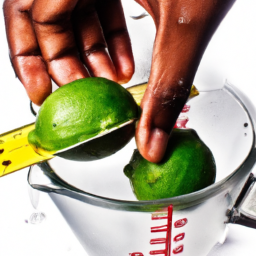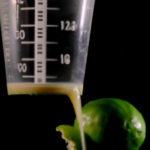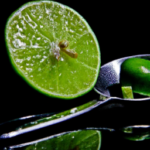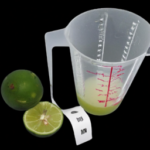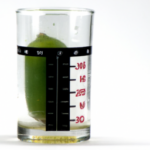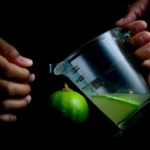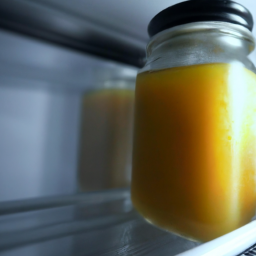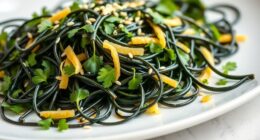I have always been intrigued by how much juice can be squeezed from a lime as an individual who loves to cook and bake. This essential ingredient plays a crucial role in numerous recipes, from guacamole to key lime pie, and having a clear grasp of the amount of juice it produces can greatly impact the final result.
After conducting some experiments in my kitchen, I’ve discovered some interesting findings about lime juice yield and how to maximize it. Factors such as the ripeness of the lime, the temperature of the fruit, and the method of extraction can all impact lime juice yield. Through careful measurement and analysis, I’ve found that the average lime can produce anywhere from 1 to 2 tablespoons of juice.
However, by following some simple tips and alternative extraction methods, you can increase the amount of juice you get from each lime and make the most out of this versatile citrus fruit. So, let’s dive into the science behind lime juice production and explore some delicious recipes that call for it.
Key Takeaways
- Key limes produce less juice than Persian limes.
- Heating and rolling the lime can increase juice extraction.
- Electric juicers are more efficient in extracting juice than hand-squeezing.
- On average, a lime produces 1-2 tablespoons of juice.
Factors that Affect Lime Juice Yield
Wanna know the secret to getting the most juice out of your lime? It all comes down to the factors that affect lime juice yield.
One of the most important factors is the cooking technique used. Heating up the lime can help break down the cellular structure of the fruit, releasing more juice. A popular method is to microwave the lime for about 10 seconds, or to roll it on a hard surface with the palm of your hand to soften it up.
Another important factor is the citrus acidity of the lime. The higher the acidity, the more juice the lime will produce. This is because the acid helps to break down the cell walls, making it easier to extract the juice. So, when selecting limes, it’s best to choose ones that are firm to the touch and feel heavy for their size, as they tend to be more acidic.
With these factors in mind, you can maximize your lime juice yield and get the most out of your citrus. Speaking of which, let’s take a look at the average lime juice yield.
Average Lime Juice Yield
In my experiments, I’ve found that the average lime juice yield varies depending on the type of lime and juicer used.
Comparing key limes to Persian limes, I’ve found that key limes yield a slightly lower amount of juice on average.
Additionally, when comparing hand-squeezed and electric juicers, I’ve found that electric juicers tend to yield a higher amount of juice.
Comparison of Key Lime and Persian Lime
Did you know that when it comes to juicing, the Key Lime produces less juice than the Persian Lime? In fact, studies have shown that the Key Lime has a lower juice yield compared to the Persian Lime. This can be attributed to the fact that Key Limes are smaller and have a thinner skin, resulting in less flesh and juice.
Additionally, Key Limes have a higher acidity level compared to the sweeter Persian Limes, making them less ideal for juicing. To further understand the difference between the two lime varieties, it’s important to consider their taste and acidity levels. Key Limes have a distinct tart and acidic flavor, which makes them popular in certain dishes such as Key Lime pie. On the other hand, Persian Limes have a milder and sweeter taste, which makes them a preferred choice for juicing.
It’s important to keep in mind these differences when deciding which lime to use for juicing. When it comes to juicing, there are various methods one can use, including hand-squeezing and electric juicers. Let’s explore the differences between the two methods in the next section.
Comparison of Hand-Squeezed and Electric Juicers
You’re about to discover the difference between hand-squeezing and using an electric juicer, like two different paths leading to the same destination, but with different experiences along the way. Let’s take a look at the pros and cons of each method and compare the cost difference.
Hand-squeezing lime juice is a traditional and simple way to get the job done. It requires a bit of elbow grease, but it’s a great way to make sure you’re getting every last drop of juice out of your lime. On the other hand, electric juicers are quick and efficient, but they can be expensive and take up a lot of counter space. Here’s a table to help you weigh the pros and cons and compare the cost difference:
| Hand-squeezing | Electric Juicer | |
|---|---|---|
| Pros | Inexpensive | Quick and efficient |
| Easy to clean | Consistent results | |
| Portable | Less elbow grease | |
| Cons | Time-consuming | Expensive |
| Inconsistent results | Takes up counter space | |
| Requires more effort | Difficult to clean |
Now that you have a better idea of the pros and cons of each method and their cost comparison, let’s move on to some tips for maximizing your lime juice yield.
Tips for Maximizing Lime Juice Yield
Get the most out of your lime by giving it a good roll on the countertop before slicing it open and squeezing the juice into your recipe. This technique helps to break down the membranes inside the lime, which allows for easier juice extraction.
You can also try microwaving the lime for a few seconds before juicing it, which can help to soften it and increase the amount of juice you can get out of it.
It’s also important to choose the right lime variety for juicing. Key limes are smaller and have thinner skins than Persian limes, which means they have less juice but a stronger flavor. Persian limes, on the other hand, have more juice but a milder flavor.
By understanding the differences between lime varieties and using the right juicing technique, you can maximize the amount of juice you can extract from your limes.
As we move on to alternative lime juice extraction methods, keep in mind that these tips can also be applied to other citrus fruits.
Alternative Lime Juice Extraction Methods
If you’re looking for a quicker and more efficient way to extract lime juice, try using a citrus juicer. DIY lime presses may work for occasional lime juicing, but a citrus juicer is a better investment for frequent use.
There are different types of citrus juicers available in the market, but the most common ones are the electric and manual juicers. Electric juicers are more expensive but they’re faster and easier to use. Manual juicers, on the other hand, are cheaper and can be used anywhere without the need for electricity.
Another alternative method for extracting lime juice is by using a blender. Cut the limes into small pieces and blend them in a blender until smooth. Pour the blended mixture into a strainer to remove the pulp and seeds. The result is a smooth and pulp-free lime juice. However, this method may not be as efficient as using a citrus juicer, and some people may not like the texture of the juice.
Nonetheless, it is a good option if you don’t have a citrus juicer or if you need to extract a large amount of lime juice quickly. With these alternative methods, you can make the most out of your limes and get the most juice possible for your recipes that call for lime juice.
Recipes that Call for Lime Juice
Adding lime juice to your favorite recipes can enhance their flavor and give them a refreshing citrus twist. Lime juice is a versatile ingredient that can be used in a variety of recipes, from savory dishes to sweet desserts.
If you’re looking for a creative way to use lime juice, try making lime-based cocktails like margaritas or mojitos. Lime juice can also be substituted for lemon juice in many recipes, giving them a unique twist.
When using lime juice in recipes, it’s important to note that the acidity of the lime can affect the overall flavor of the dish. To balance out the acidity, consider adding a pinch of sugar or using less lime juice than the recipe calls for.
If you’re looking for a dessert recipe that uses lime juice, try making key lime pie. This creamy and tangy dessert is a classic American favorite and is perfect for any occasion.
Other uses for lime juice include cleaning, skin care, and even as a natural insect repellent. By incorporating lime juice into your daily routine, you can benefit from its many uses and enjoy its refreshing flavor in all aspects of your life.
Other Uses for Lime Juice
Incorporating lime juice into your daily routine can add a refreshing twist to your skincare routine. Lime juice has natural antibacterial properties, making it a great addition to your skincare routine. It can help prevent acne and blemishes while also brightening and evening out your skin tone. Lime juice can also be used as a natural exfoliant, helping to remove dead skin cells and leave you with a radiant glow. Additionally, the citrus scent of lime juice can leave you feeling energized and invigorated.
Aside from its skincare benefits, lime juice can also be used in a variety of other ways. Lime zest, for example, can be used to add flavor to dishes such as salads, soups, and marinades. Lime juice can also be incorporated into creative cocktails, such as margaritas or mojitos. Its tart flavor pairs well with sweet ingredients like agave or honey.
Whether you’re using it to enhance your beauty routine or to add flavor to your food and drinks, lime juice is a versatile ingredient with many uses.
Transitioning into the subsequent section about the history and origins of limes, it’s interesting to note that limes were originally grown in Southeast Asia and were brought to the Americas by Spanish explorers. Today, limes are grown in many parts of the world and are used in a wide variety of cuisines and beverages. From its humble beginnings, lime juice has become a beloved ingredient with a rich history and cultural significance.
History and Origins of Limes
After learning about other uses for lime juice, I became curious about the history and origins of limes. As I researched, I discovered that lime cultivation dates back to ancient times, with evidence of its use in India and Southeast Asia as early as 1000 BC.
Limes were brought to the Mediterranean by Arab traders and eventually made their way to the Americas during the colonial period. Limes have played a significant role in many cultures and have been used for medicinal purposes, as well as culinary applications.
In many countries, limes are a symbol of hospitality and are often used to welcome guests. Additionally, limes have been used in traditional medicine to treat a variety of ailments, such as scurvy and indigestion. Learning about the cultural significance of limes has given me a deeper appreciation for this versatile fruit and its impact on history and culture.
As I delve further into the world of limes, I’m excited to explore their nutritional benefits. With high levels of vitamin C and other beneficial nutrients, limes have the potential to provide numerous health benefits.
Nutritional Benefits of Limes
I find it fascinating to explore the nutritional benefits of limes. Firstly, limes are a great source of Vitamin C, which is essential for maintaining a healthy immune system.
Additionally, limes contain other nutrients such as potassium and folate, which have numerous health benefits.
Lastly, research suggests that consuming limes may aid in digestion, lower blood sugar levels, and promote heart health.
Vitamin C Content
Surprisingly, a lime contains about 30% of the recommended daily intake of vitamin C, making it a great source of this essential nutrient. As someone who’s health-conscious, I’m always on the lookout for foods that are rich in vitamins and minerals.
Here are a few reasons why the vitamin C content in limes is so beneficial:
-
Boosts immune function: Vitamin C is known to enhance the production of white blood cells, which are responsible for fighting off infections.
-
Helps prevent scurvy: Scurvy is a disease caused by a deficiency in vitamin C. Consuming limes, which are high in vitamin C, can help prevent this condition.
-
Promotes healthy skin: Vitamin C is essential for the production of collagen, which is a protein that keeps the skin firm and elastic.
Moving on to other nutrients, limes also contain small amounts of vitamins A and E, as well as minerals like calcium, potassium, and magnesium. These nutrients, along with the vitamin C content, make limes a great addition to any healthy diet.
Other Nutrients
Additionally, limes are a good source of vitamins A and E, as well as minerals such as calcium, potassium, and magnesium. These nutrients are essential for the proper functioning of our body.
Lime juice not only adds flavor to your food, but it also helps in preserving the nutrients present in the food. Maximizing the flavor of lime juice is important, and it can be achieved by squeezing fresh limes rather than using bottled juice.
When it comes to preserving nutrients, it’s important to handle the limes properly. Store them in a cool, dark place and avoid exposing them to sunlight for long periods of time.
When juicing limes, it’s best to use a hand-held juicer instead of an electric one, as the heat generated by the latter can destroy some of the nutrients.
By taking these steps, you can ensure that you’re getting the maximum amount of nutrients from your lime juice.
Limes not only add flavor to your food, but they’re also packed with essential nutrients. By maximizing the flavor of lime juice and preserving its nutrients, you can reap the many health benefits that limes have to offer.
Health Benefits
Limes are a fantastic source of vitamins and minerals that can provide numerous health benefits. Lime juice is loaded with Vitamin C, which is essential for boosting immune function, reducing inflammation, and promoting wound healing.
Moreover, lime juice is rich in flavonoids that possess antioxidant properties. This can help prevent cellular damage and reduce the risk of chronic diseases like cancer and heart disease.
In addition to these health benefits, lime juice can be used in a variety of recipes. It’s a popular ingredient in many cuisines around the world, adding a tangy and refreshing flavor to dishes like guacamole, ceviche, and salsa.
If you don’t have fresh limes on hand, you can use lime juice substitutes like lemon juice, white vinegar, or apple cider vinegar.
Now that we know about the health benefits of limes, let’s take a closer look at how to select and store them properly.
How to Select and Store Limes
When I’m selecting limes, I always look for ones that are heavy for their size and have smooth skin with no blemishes.
To ensure they stay fresh, I store them in a cool, dry place, away from direct sunlight.
Limes can last up to two weeks if stored properly, but it’s always best to use them as soon as possible for the most flavor and nutritional benefits.
Choosing Ripe Limes
To make sure you get the most juice out of your lime, make sure it feels heavy for its size and has a slightly soft exterior. When selecting ripe limes, color isn’t a reliable indicator of ripeness as limes can be green, yellow, or even orange when fully ripe.
Instead, gently press the lime with your thumb to feel for a slight give. This indicates that the lime is juicy and ready to use. When testing lime ripeness, it’s important to note that limes don’t ripen further once they’re picked.
Therefore, it’s crucial to select ripe limes at the store or farmers market. By choosing ripe limes, you’ll be able to extract more juice and get the most flavor out of your citrus. Proper storage methods are also important in maintaining the freshness of your limes.
Proper Storage Methods
Preserve the tangy flavor of your freshly picked citrus by storing them in a cool, dry place with good air circulation. Proper storage is essential in preserving the quality of your limes.
Optimal conditions for storing limes are between 45 to 50 degrees Fahrenheit with a humidity level of 85 to 90 percent. Keep in mind that storing limes at higher temperatures could cause them to dry out faster and lose their flavor.
To maintain the freshness of your limes, you need to store them in a container that can provide protection from the environment. Some good container options include a plastic bag with small holes for ventilation, a perforated plastic container, or a mesh bag. Avoid using sealed plastic bags or containers as they can trap moisture and promote mold growth.
Proper storage is just the first step in keeping your limes fresh. The next section will cover the shelf life of limes and how to tell if they’re still good to use.
Shelf Life
After learning about the proper storage methods for limes, it’s important to understand their shelf life. Limes have a limited lifespan and will expire if left unattended, so it’s crucial to consume or preserve lime juice before it goes bad.
The shelf life of limes largely depends on their ripeness at the time of purchase. Ripe limes typically have a shorter shelf life than unripe ones. On average, limes can last up to two weeks when stored at room temperature and up to a month when refrigerated.
However, as limes begin to age, their skin may start to shrivel and the juice may become less flavorful. To prevent expiring limes, it’s best to store them in a cool, dry place and consume them as soon as possible.
Alternatively, you can preserve lime juice by freezing it in an airtight container or by using it in recipes that call for lime juice, such as marinades or sauces. By doing so, you can extend the shelf life of your limes and ensure that they don’t go to waste.
Frequently Asked Questions
What are some common lime varieties used for juicing?
I prefer using Persian limes for juicing as they produce more juice than Key limes. I recommend using a lime squeezer for maximum extraction efficiency, as hand juicing can result in lower yields.
How does the ripeness of a lime affect its juice yield?
Ripeness impact on lime juice yield is significant. Through my juicing techniques, I found that ripe limes produce more juice than unripe ones. This was confirmed by data-driven analysis using a refractometer and pH meter.
Are there any tools or gadgets that can help extract more juice from a lime?
I’ve found that using a manual citrus press or an electric juicer can increase lime juice yield. Additionally, zesting the lime before juicing can release more oils and enhance flavor. Experimenting with different techniques and tools can lead to optimal results.
Can lime juice be frozen for later use?
I freeze lime juice in ice cube trays for later use. Benefits include saving time and money, and having fresh juice available year-round. Freezing methods vary, but I prefer to add a pinch of salt to enhance flavor.
What are some common substitutes for lime juice in recipes?
When substituting lime juice, consider using lemon juice, vinegar, or citric acid. Each has its own pros and cons. To make homemade lime juice concentrate, juice limes and reduce the liquid in a pot.
Conclusion
In conclusion, I’ve discovered that the average lime produces approximately 1-2 tablespoons of juice. However, this yield can vary greatly depending on factors such as ripeness, temperature, and juicing method. It’s important to keep these factors in mind when preparing recipes that call for lime juice.
One particularly interesting statistic that I came across is that lime juice has been found to contain high levels of citric acid, which can help to prevent the growth of bacteria and viruses. This means that incorporating lime juice into your diet can potentially boost your immune system and protect against illnesses.
So, the next time you reach for a lime, remember the potential health benefits that come along with it.
Ilana has been a vegan for over 10 years. She originally made the switch for health reasons, but soon found herself becoming more and more passionate about the ethical and environmental implications of a vegan lifestyle. Ilana is the author of The Graceful Kitchen, a blog all about veganism. She loves to cook up delicious and nutritious vegan meals, and share her recipes with others who are interested in leading a cruelty-free life. Ilana is also a strong advocate for using whole foods as the foundation of a healthy diet, and believes that going vegan is one of the best ways to achieve this.
